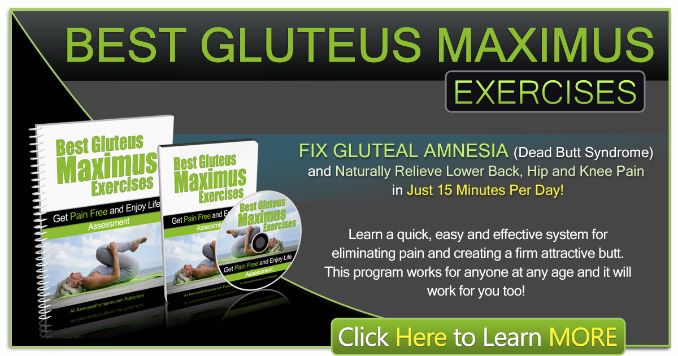As we age, maintaining a healthy lifestyle is crucial. Strengthening the glute muscles is vital for mobility and stability in seniors. This article explores glute exercises for seniors, promoting balance, stability, and proper posture and reducing the risk of falls. These exercises also address common issues like lower back pain and knee discomfort.
Whether you’re a senior or a caregiver, these exercises, with step-by-step instructions and modifications, are a valuable addition to any fitness routine. Investing in glute muscle strength enhances the quality of life as you age, fostering a path to healthy aging. Let’s embrace these exercises together.
Importance Of Exercise For Seniors
Seniors who regularly engage in physical activity can experience several health benefits. Exercise helps maintain muscle strength and flexibility and improves balance [¹] and coordination, lowering the likelihood of experiencing falls. Additionally, it aids in controlling weight, promoting good mental health, and decreasing the risk of chronic diseases like heart disease, diabetes, and osteoporosis.
However, many seniors may struggle to maintain a consistent exercise routine due to physical limitations or other challenges. This is where targeted glute exercises can be beneficial, as they can be performed in various settings and do not require specialized equipment.
Benefits Of Glute Exercises For Seniors
The glute muscles are among the body’s largest and most powerful muscles. They play a vital role in overall mobility, improving balance and stability, helping us walk, stand, climb stairs, and maintain balance. Strengthening the glutes can also help alleviate lower back pain and knee pain and discomfort, two common issues many seniors face.
Regular Standing glute exercises help improve balance and stability and promote better posture. They can also lower the risk of falls, which is particularly important for seniors at higher risk of injury because of diminished bone density or other physical limitations.
Common Challenges For Seniors When It Comes To Glute Exercises
While glute exercises can benefit seniors, there are also some common challenges. Many seniors may struggle with mobility or balance issues, making specific exercises difficult or dangerous. Others may have existing injuries or conditions that limit their range of motion or make certain activities uncomfortable.
Talking with a healthcare professional before doing any new exercise routine is essential, especially if you have underlying health conditions or mobility issues. Your provider can help you determine which exercises are safe and align with your needs and goals.
Safety Considerations For Seniors When Performing Glute Exercises
When performing glute exercises, safety should always be a top priority. Seniors should start their exercise routine at a gentle pace, progressively elevating the intensity and duration of their workouts as they develop core strength and endurance. Proper form and technique are also important to avoid injury or strain to hip muscles.
Additionally, seniors should always listen to their bodies and replace exercises that cause pain or discomfort. It is better to start with more straightforward exercises and slowly work up to more challenging ones as you build strength, better balance, and confidence.
Effective Glute Exercises For Seniors
Seniors can incorporate many practical glute exercises into their fitness routine.
Warm-Ups
1. Shoulder Rotation
Begin in an upright standing position with your feet shoulder-width apart, maintaining good alignment with your head, shoulders, hips, and legs. Step your one foot back to stagger your feet. Engage your core and lift your shoulders, then roll them down and back until you feel resistance in your shoulder blades. Then, lower your shoulders to the starting position, relax, and repeat the movement in the opposite direction—complete 10 repetitions.
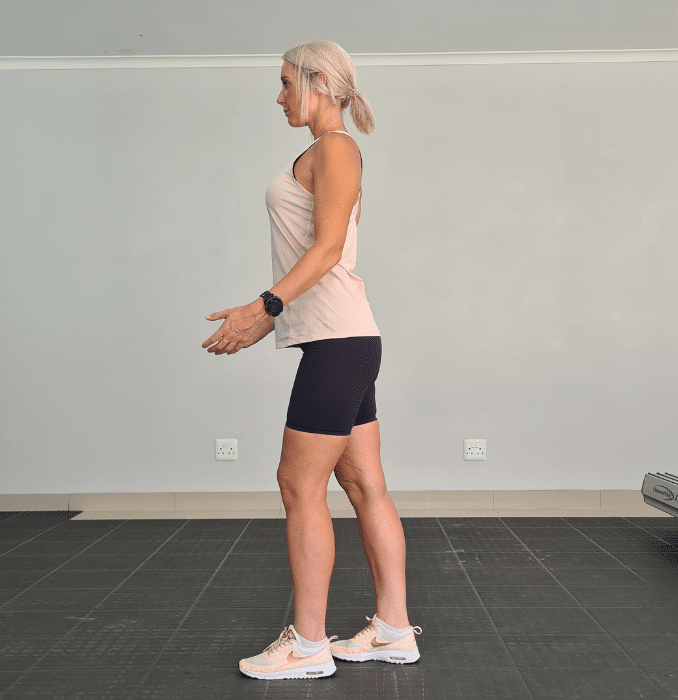 | 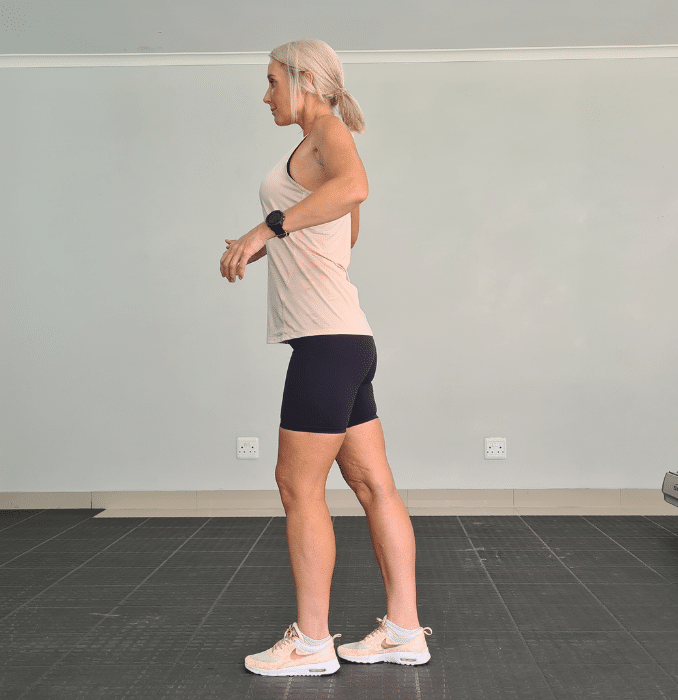 |
2. Swimming Motion
Firstly, begin in an upright standing position with your feet shoulder-width apart, maintaining good alignment with your head, shoulders, hips, and legs. Secondly, place your arms at your sides. Thirdly, engage your core and swing one arm forward in a big circular motion. Then, alternate the movement with your opposite arm, similar to a forward swimming motion. Lastly, after several repetitions, perform the movement in the opposite direction. Start with 10 repetitions in each direction.
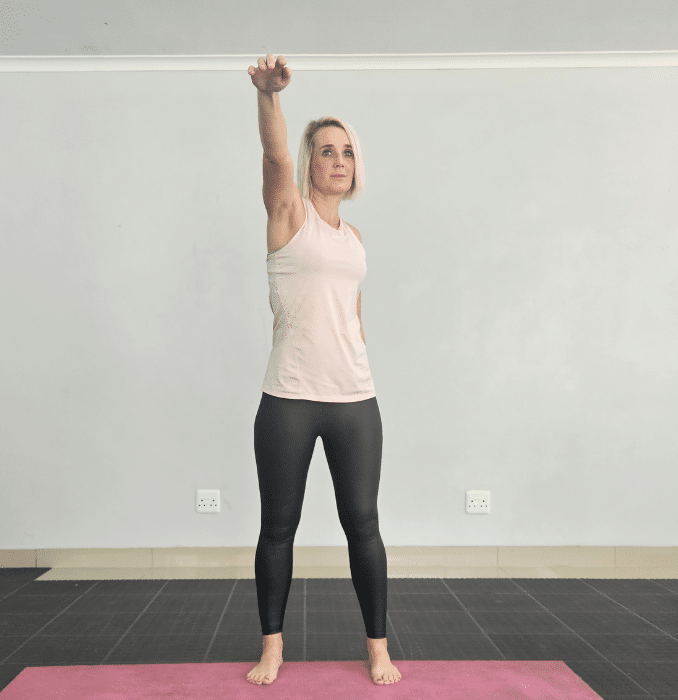 | 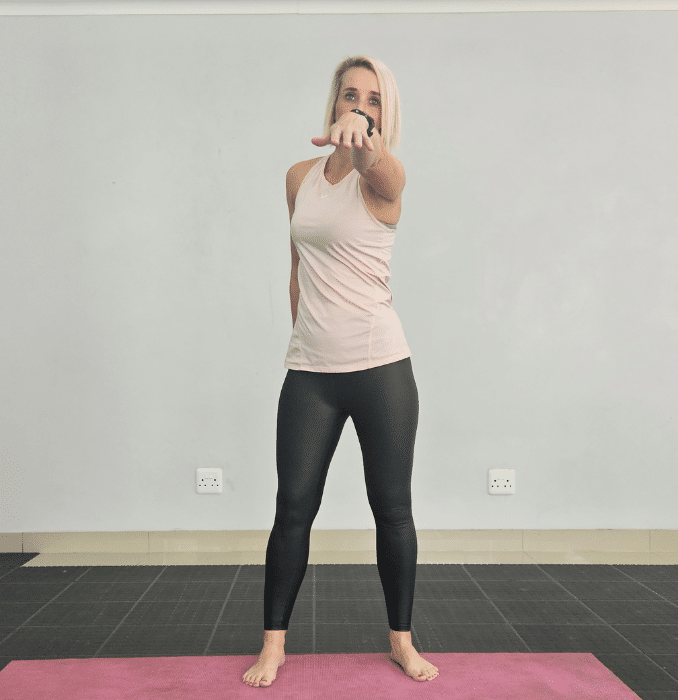 |
3. Squats
Begin in an upright standing position with your feet hip-width apart, maintaining good alignment with your head, shoulders, hips, and legs. Then, Place your hands on your hips. Afterward, engage your core and hinge through your hips to move into a squat position. And then, keep your knees behind your toes. Raise back up to an upright standing position, squeezing your glutes at the top. Lastly, repeat the movement and complete 10 repetitions.
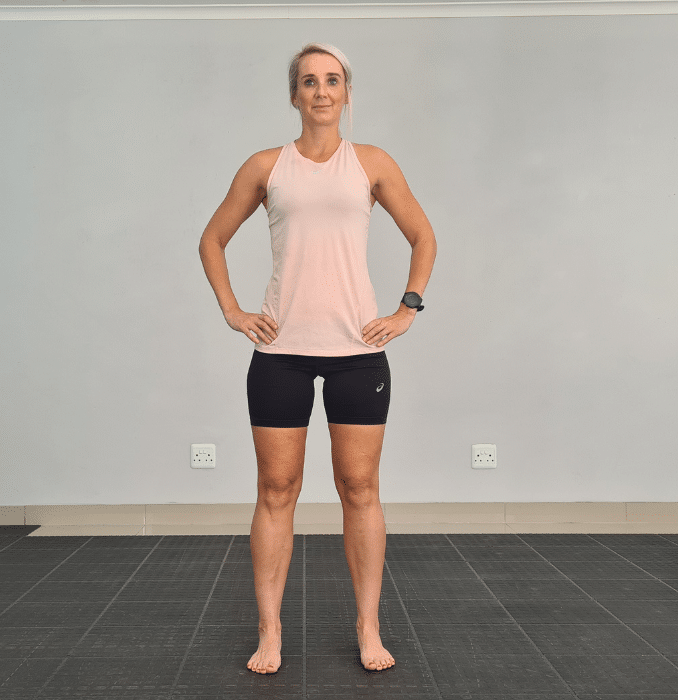 |  |
4. Standing Rows
Firstly, begin upright with your feet shoulder-width apart, maintaining good alignment with your head, shoulders, and hips. Secondly, Engage your core. Thirdly, slightly bend your knees and extend both arms straight in front of your body at chest height. Fourthly, engage your core and pull your arms back in a rowing motion, squeezing your shoulder blades together and keeping your elbows close to your body. Lastly, return to the starting position and repeat the movement for 10 repetitions.
 |  |
5. Good Morning
Begin in an upright standing position with your feet wider than shoulder-width apart, maintaining good alignment with your head, shoulders, and hips. Then, interlace your fingers behind your head or place your hands by your ears. Engage your core, then slowly bend forward through your hips until your upper body is parallel to the floor. Finally, Raise back up to return to the starting position, squeezing your glutes at the top. Repeat the movement and complete for 10 repetitions.
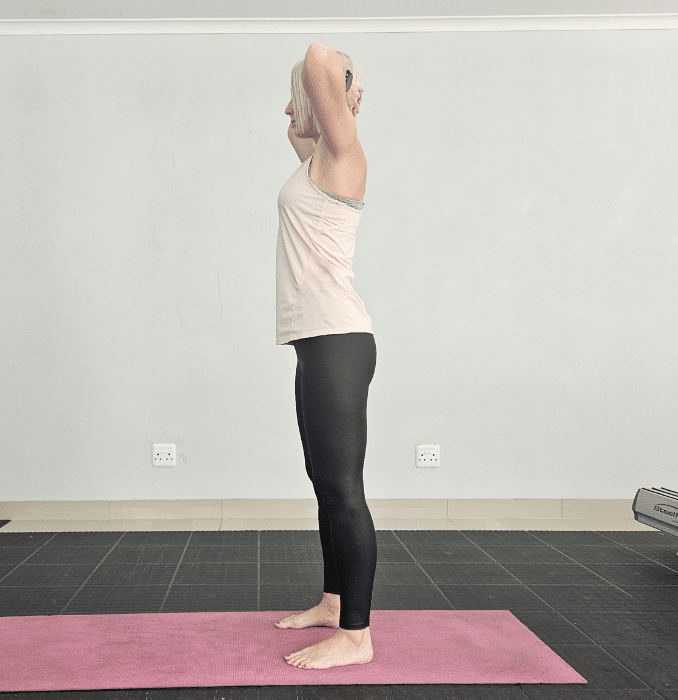 | 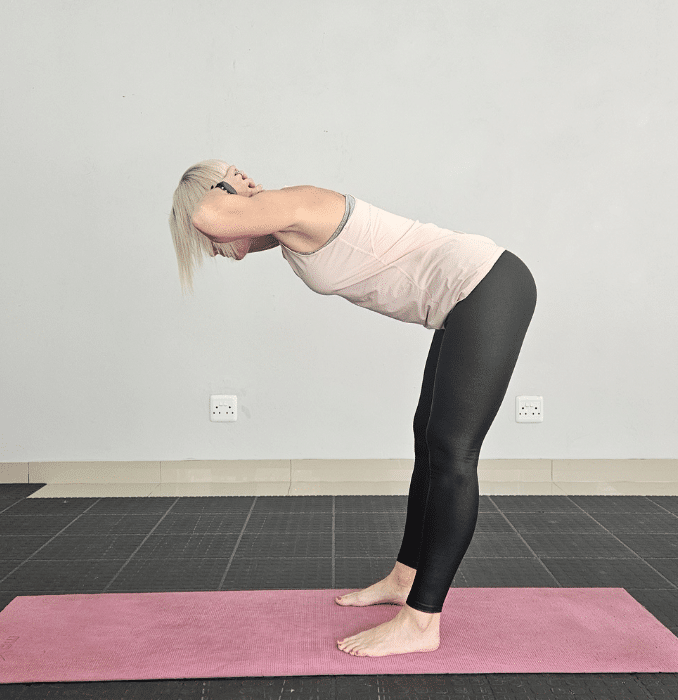 |
Routine
1. Bridge
Firstly, lie on your back with your knees bent and your feet flat on the floor, maintaining a good alignment with your head, shoulders, and hips. Secondly, place both hands at your sides with your feet shoulder-width apart. Engage your core, then push from your heels to lift your hips, squeezing your glutes at the top. Then, hold the position for a couple of seconds. Lastly, Lower your hips back down to return to the starting position. Repeat the movement for 10 repetitions.
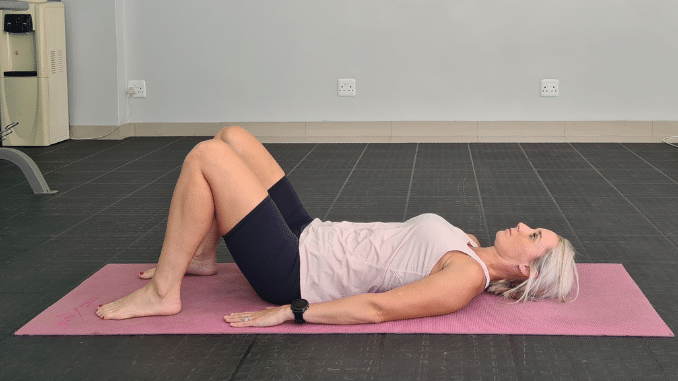 |
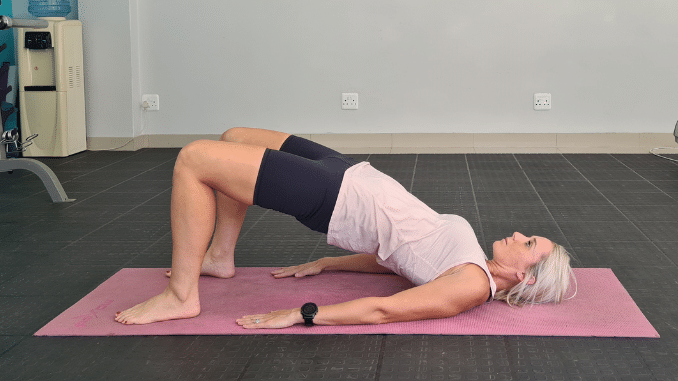 |
Note: To make the exercise more challenging, place your feet on the seat of a chair or cross one ankle over your opposite knee.
2. Glute Kickback
Firstly, begin in a 4-point position with your hands beneath your shoulders and your knees under your hips. Secondly, engage your core. Thirdly, shift your weight onto your one knee and kick your opposite leg back up, contracting your glutes at the top position. Finally, return to the starting position and complete for 10 repetitions. Repeat the movement on the opposite side.
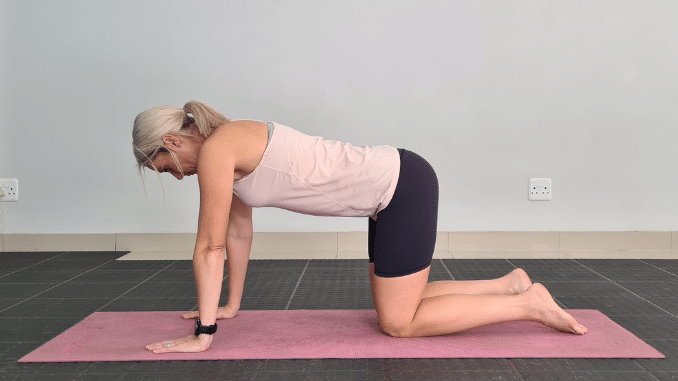 |
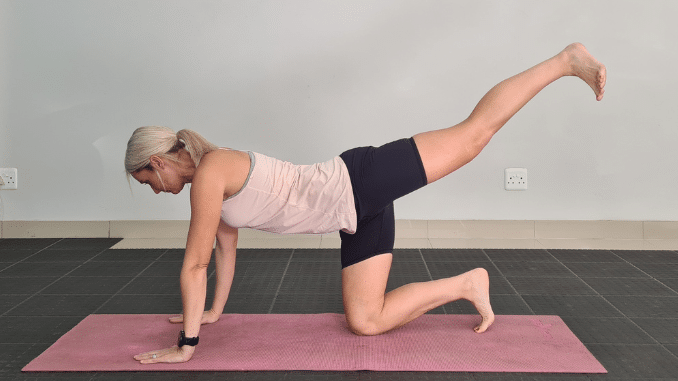 |
3. Kickbacks
Hold on to the back of a chair or couch for support and balance for this exercise.
Firstly, begin in an upright standing position with your hands on the back of a sturdy chair for balance, maintaining good alignment with your head, shoulders, hips, and legs. Slightly lean on the chair, then engage your core. Afterward, Shift your weight onto your right leg, pull your opposite knee into your chest, and kick your left leg straight back.
Return to the starting position and repeat the movement. After several repetitions, repeat the movement on the opposite side. Start with 1 set of 8 repetitions on each side.
 | 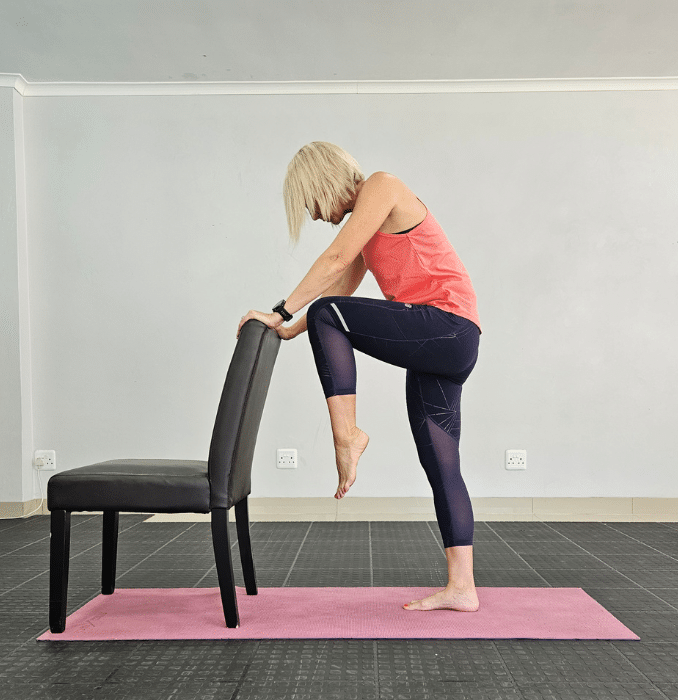 | 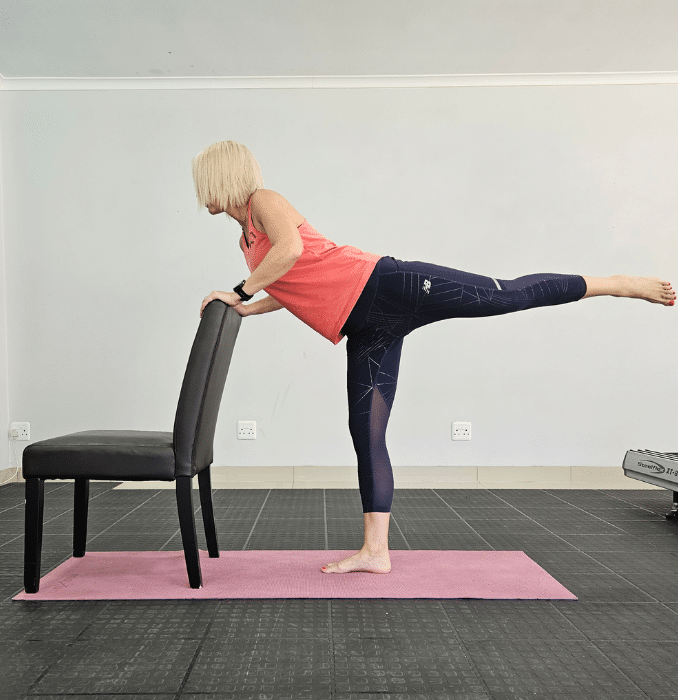 |
4. Plié Squat
Begin in an upright standing position with your feet considerably wider than shoulder-width apart, maintaining good alignment with your head, shoulders, and hips. Secondly, place your hands by your ears or interlace your fingers behind your head. Thirdly, engage your core. Fourthly, Bend your knees and hinge through your hips to move into a deep squat position, keeping your knees behind your toes. Lastly, Raise back up to return to the starting position, squeezing your glutes at the top.
Repeat the movement for 8 repetitions.
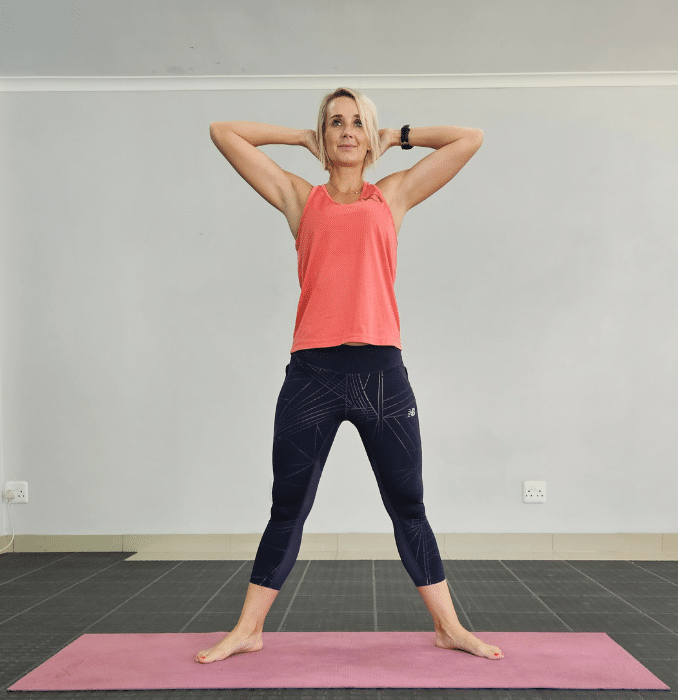 | 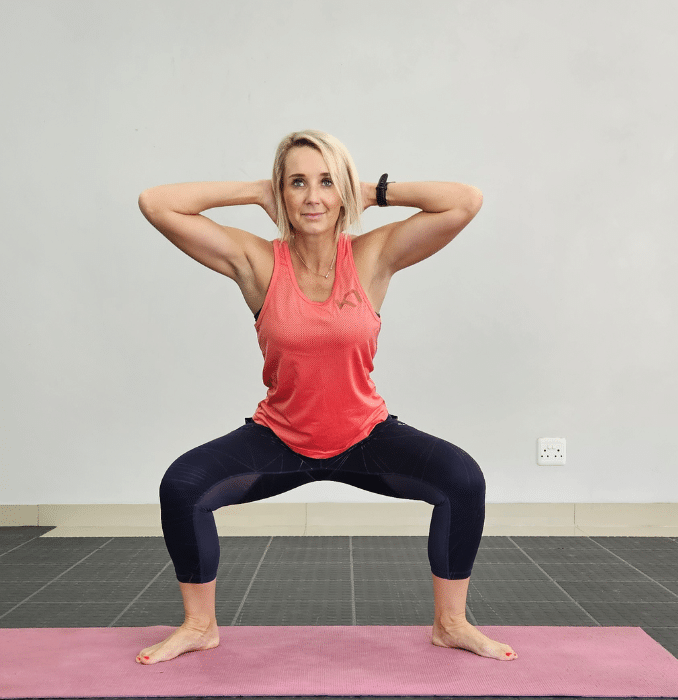 |
5. Chair Squats
Begin in an upright standing position in front of a chair with your feet slightly wider than shoulder-width apart, maintaining good alignment with your head, shoulders, and hips. Then, press your palms together in front of your body at chest height and engage your core. Afterward, Bend your knees and hinge through your hips to lower into a squat position on the chair. Lastly, return to an upright standing position, squeezing your glutes at the top. Perform the movement for 8 repetitions.
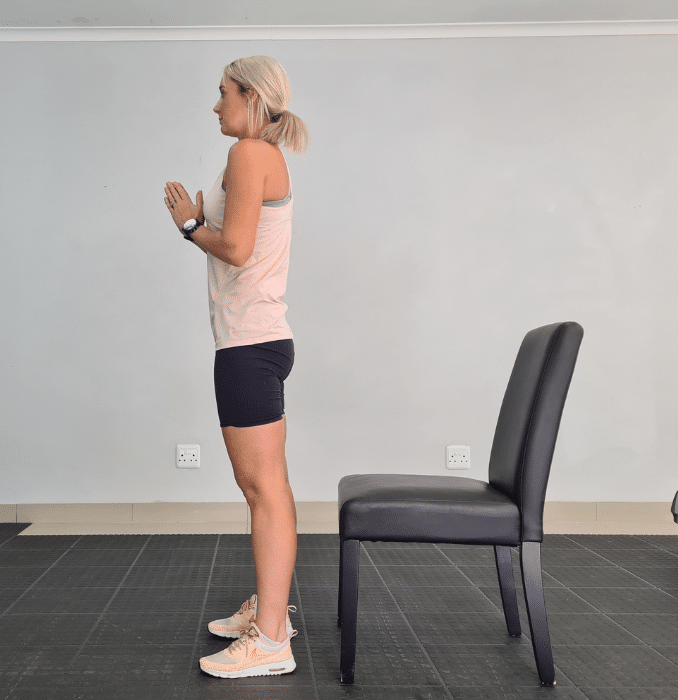 | 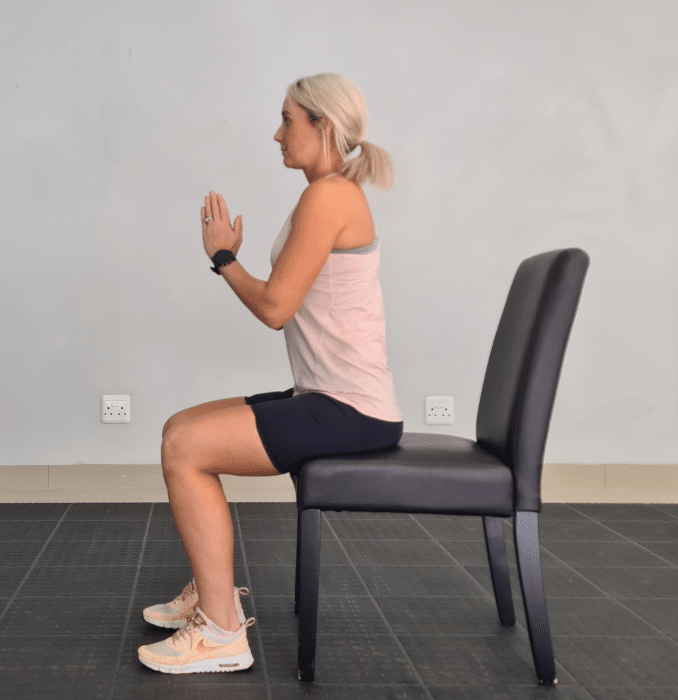 |
Begin in an upright sitting position with your knees bent and feet flat on the floor, maintaining good alignment with your head, shoulders, and hips. Then, lift one foot off the floor. Afterward, engage your core and move into a standing position, balancing your body weight onto your supporting leg. And then, Sit back down to return to the starting position. Lastly, repeat the movement on the opposite side. Start off with 1 set of 8 repetitions on each side.
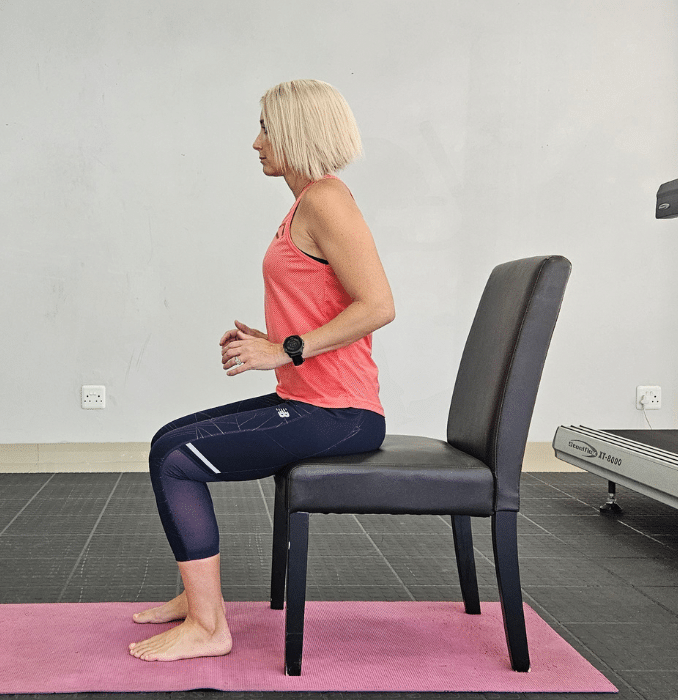 | 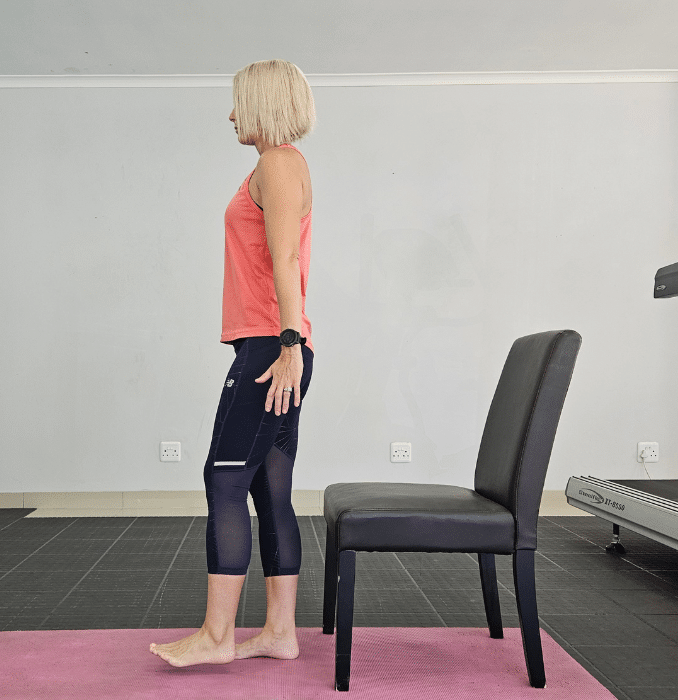 |
Note: If you find yourself struggling with this movements, you can do the regular bodyweight squat.
6. Knee Drives
Firstly, begin in an upright standing position with your legs hip-width apart, maintaining good alignment with your head, shoulders, hips, and legs. Secondly, Engage your core. Thirdly, twist your upper body to the side and drive your one knee up towards your chest as you counter the movement with your opposite elbow. Then, Return to the starting position and repeat the movement on the opposite side. Lastly, start off with 1 set of 10 repetitions on each side.
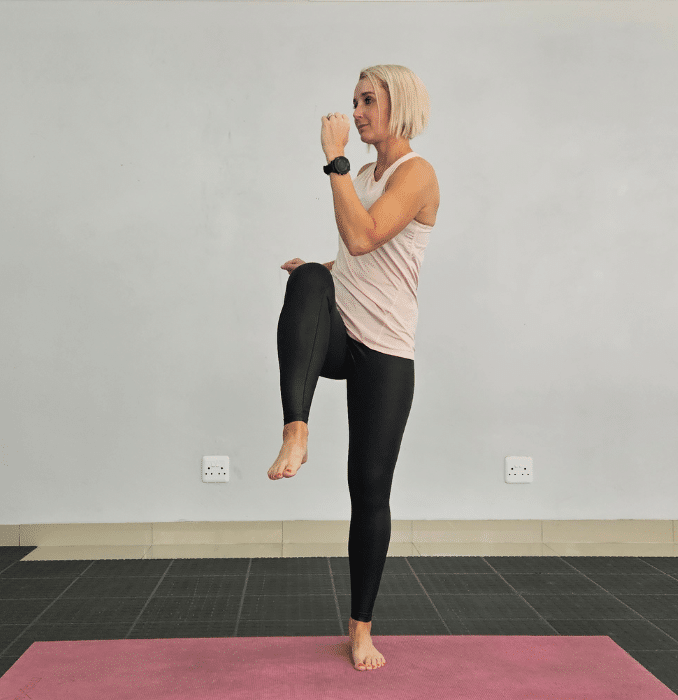 | 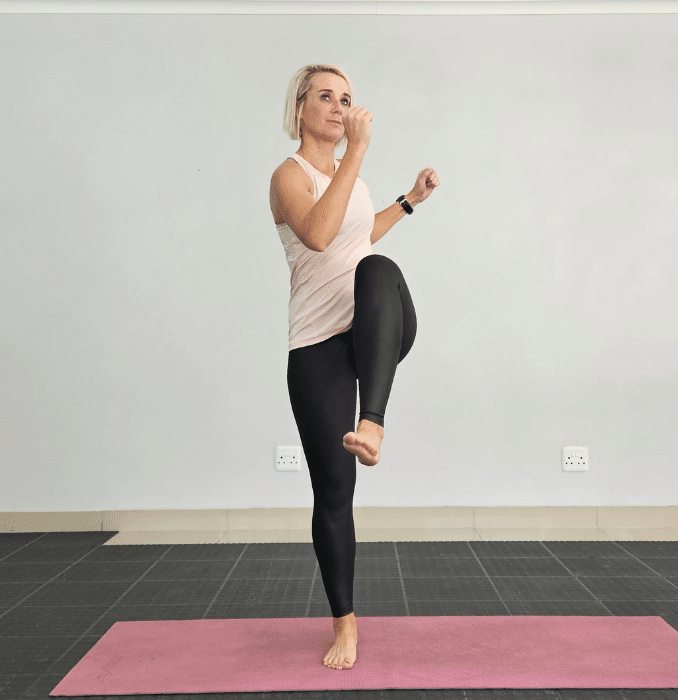 |
7. Curtsy Lunges
Begin in an upright standing position with your feet hip-width apart, maintaining good alignment with your head, shoulders, and hips. Place your hand on your hips. Engage your core, and then take a big step back with your left foot, lowering your knee at your side, down towards the floor while bending your front knee. Then, keep your toes pointing straight ahead. Finally, step back up to an upright standing position and repeat the movement on the opposite side. Start with 1 set of 10 repetitions on each side.
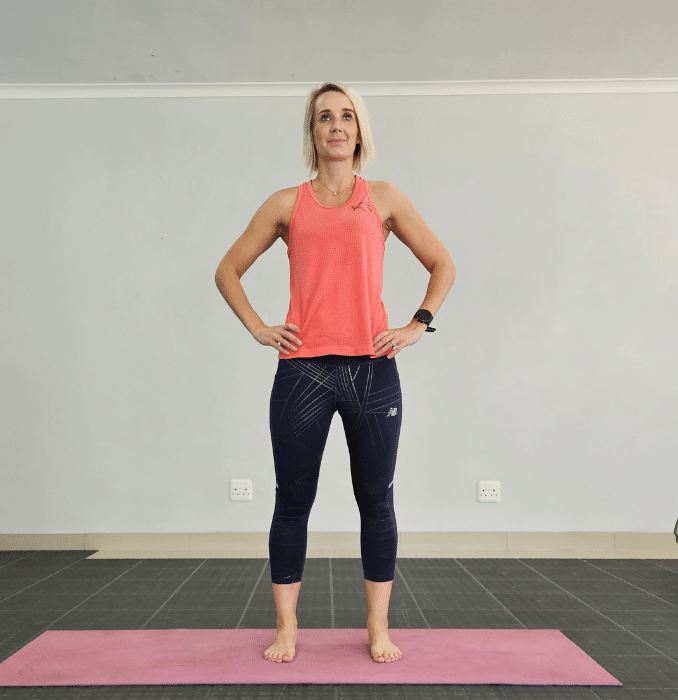 | 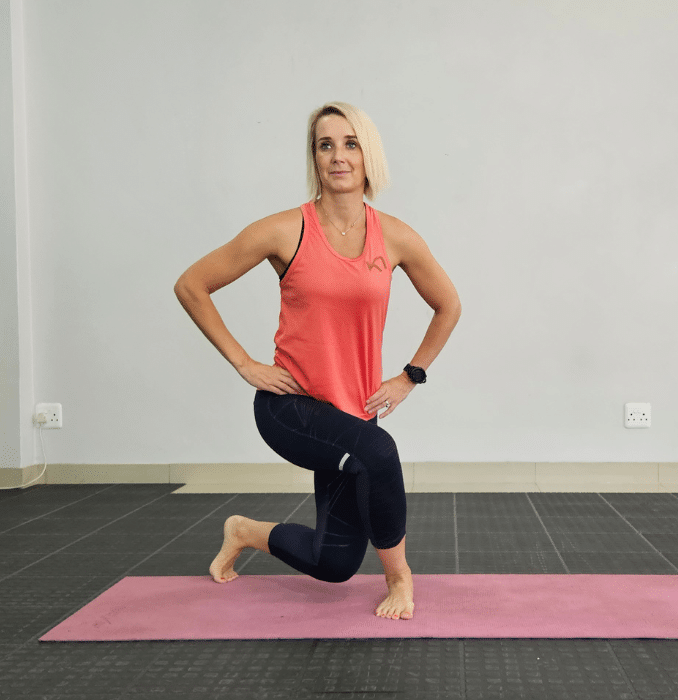 | 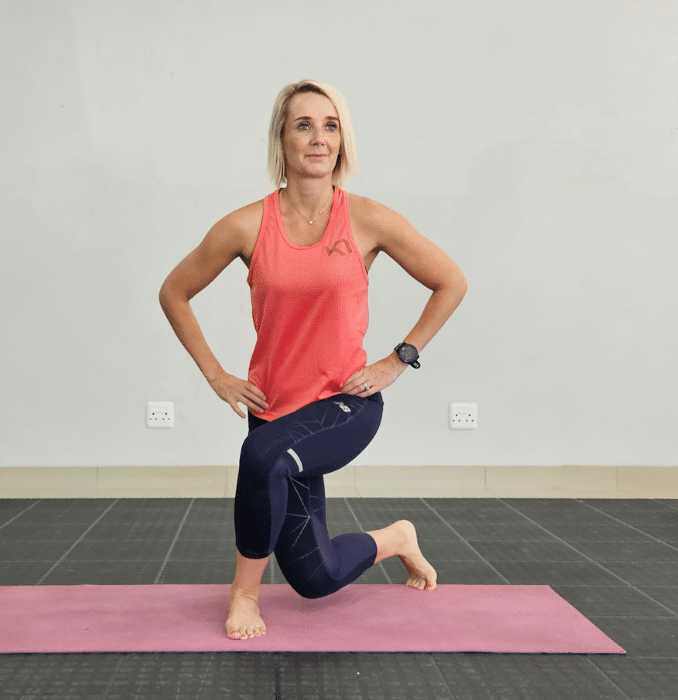 |
Perform one more set of the Plié Squat and Bridge to complete the routine.
Cool Down
1. Butterfly Pose
Firstly, begin in an upright sitting position on the floor with your knees bent and feet flat on the floor. Secondly, bring the soles of your feet together in front of your body and straighten your spine. Thirdly, Engage your core and open your knees out to the sides. Grab your toes with both hands and lean your head back. Finally, hold this position for 3 deep belly breaths, in through your nose and out through your mouth. Relax and return to the starting position.

Note: To intensify the movement, extend both arms overhead, then slowly fold your upper body forward, lowering your hands and head to the floor.
2. Cat-Cow
Begin in a 4-point position with your hands beneath your shoulders and your knees under your hips. Engage your core. Slowly lower your head as you round your mid-back, then alternate by raising your head and arching your mid-back. lastly, repeat the movement, alternating directions. Start with 1 set of 5 repetitions.
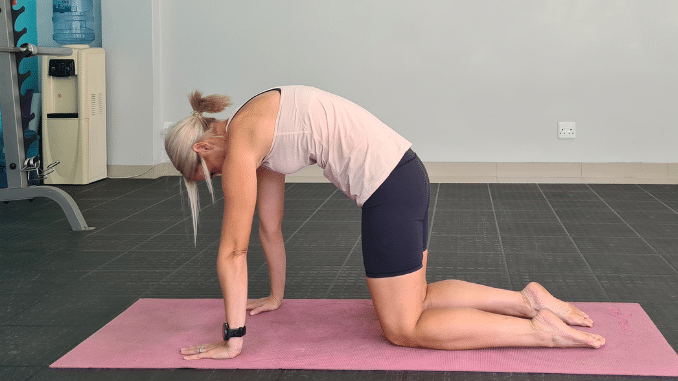 |
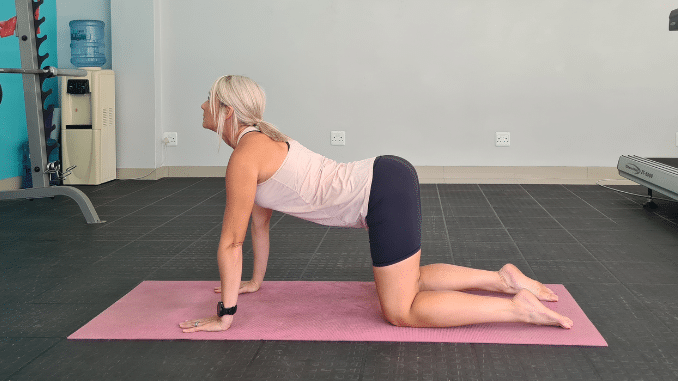 |
Cat Cow: Variation 1
From the 4-point position, engage your core and widen your knees. Shift your hips back to your feet while extending both arms in front of your body. Then, lower your head to the floor, relaxing your midback area for a light stretch. Finally, hold this position for three deep belly breaths, in through your nose and out through your mouth.
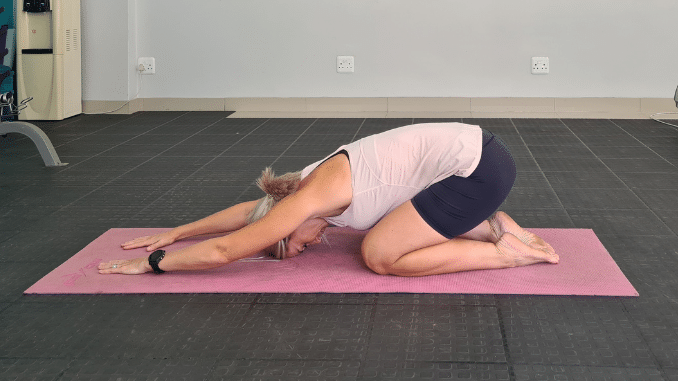
3. Downward-Facing Dog With Hamstring Stretch
Firstly, move into a 4-point position with your knees below your hips and your hands beneath your shoulder. Secondly, engage your core and push back with your arms, straightening your legs as you lift your hips. Thirdly, bend one knee, keeping your other leg straight. Lastly, return to the starting position and repeat the movement on the opposite leg. Complete for 5 repetitions, alternating sides.
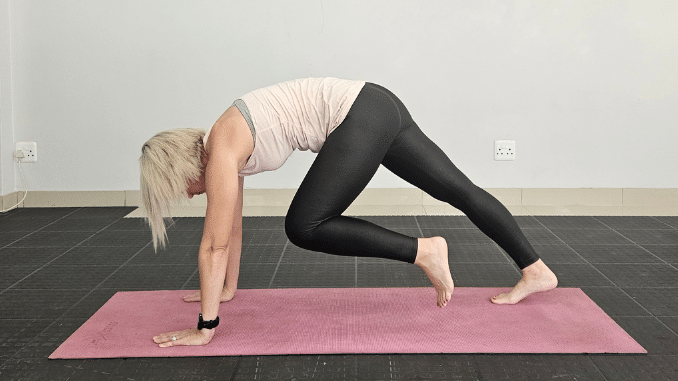 |
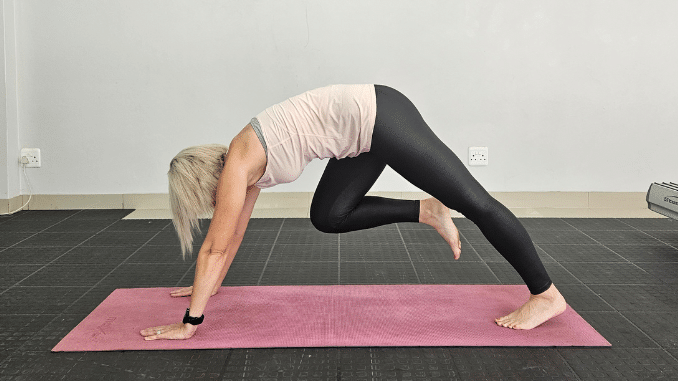 |
4. Overhead Reach With Side Bend
Begin in an upright standing position with your feet shoulder-width apart, maintaining good alignment with your head, shoulders, hips, and legs. Then, interlace your fingers and bring your hands overhead. Afterward, engage your core and bend your upper body to the side, opening through the side of your body by tilting your chest upward. Hold this position for several deep belly breaths, in through your nose and out through your mouth. Finally, slowly return to the starting position and repeat the movement on the opposite side.
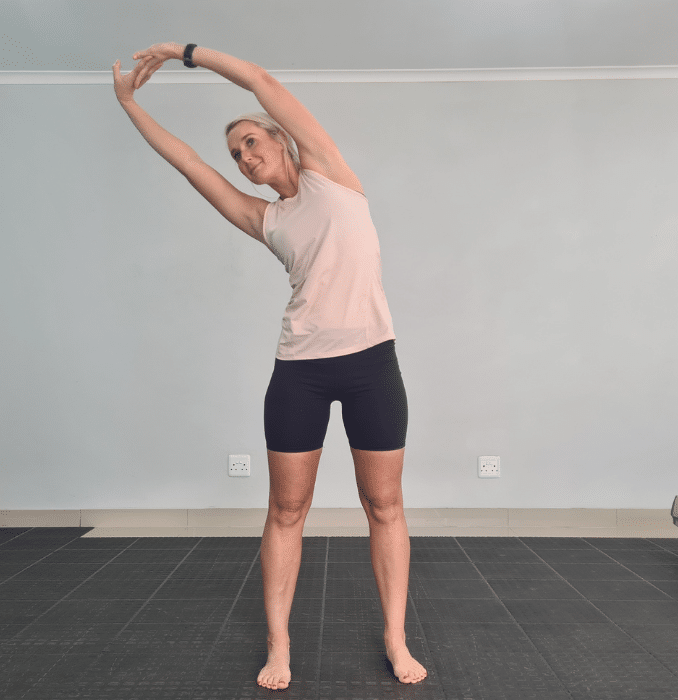 | 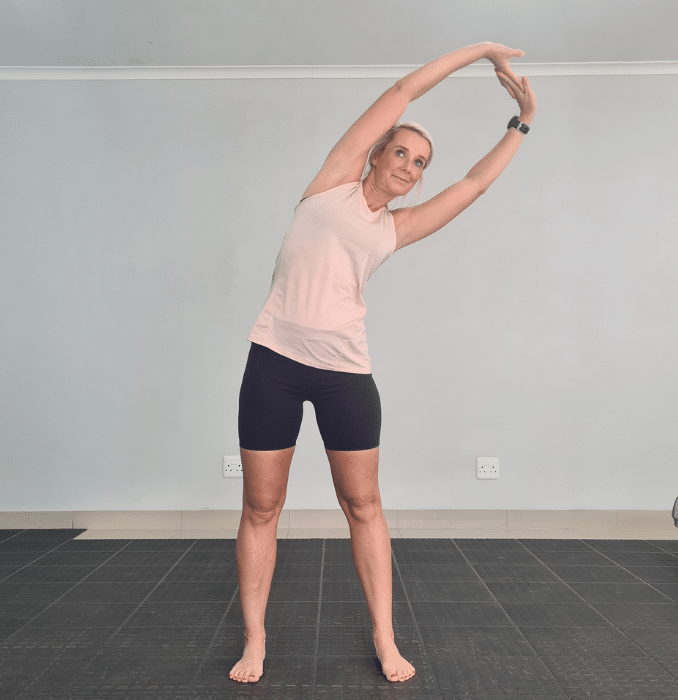 |
Incorporating Glute Exercises Into A Senior Fitness Routine
Incorporating glute exercises into a senior fitness routine can greatly benefit overall health and well-being. Strong glutes are essential for stability, balance, and mobility, which are crucial as we age.
Here are some valuable insights and tips to help seniors integrate glute exercises into their fitness routine and promote healthy aging:
1. Start Slow
For seniors who may not have been active for a while, it’s essential to begin slowly and gradually. Initiate your routine with just a few basic glute exercises. This cautious approach indeed helps prevent injuries [²] and allows your body to adapt to the new regimen.
2. Mix It Up With Resistance Bands
Integrate resistance bands into classic exercises.
For instance:
Squat With Resistance Bands
Wrap the resistance band just above the knees while performing squats to engage the outer glutes.
In this exercise, wrap the resistance band just above the knees and perform lunges to target the glutes and thighs.
Hip Bridges With Resistance Bands
Wrap the resistance band just above the knees during hip bridges to activate the glutes effectively.
3. Be consistent
Make exercise a regular part of your daily or weekly routine by scheduling it like any other appointment. Consistency is crucial in reaping the benefits of exercise, such as improved strength, balance, and mobility. Consider finding a workout buddy or joining a senior fitness class to help with motivation.
4. Proper Form
Ensure that you use proper form during your exercises. This lowers the risk of injury and maximizes the effectiveness of the exercises. If you’re new to exercise or have any concerns, consider working with a fitness professional or physical therapist who can provide guidance and monitor your progress.
Conclusion: Emphasizing The Importance Of Glute Exercises
Strengthening the glute muscles is an essential aspect of healthy aging. Regular glute exercises help improve balance and stability. A stronger core reduces the risk of falls and alleviates lower back pain and knee discomfort. Seniors at various fitness levels can benefit from incorporating targeted glute exercises into their fitness routine, and there are many resources and tools available to help them do so safely and effectively. Seniors can enhance their overall well-being as they age by investing time and effort to strengthen their glute muscles.
Have you been waiting for a solution that will ACTUALLY WORK? That REALLY WILL decrease and eliminate your hip or back pain? This is what you can look forward to when you get our Best Gluteus Medius Exercises program now!


